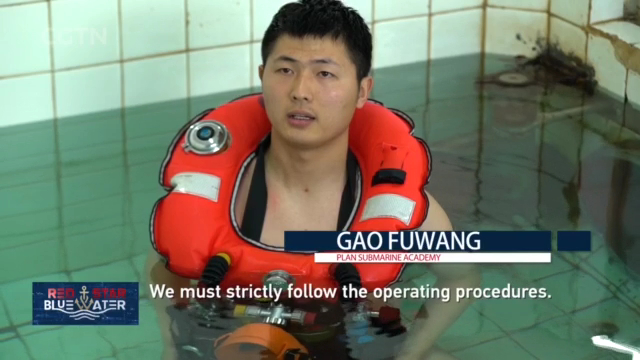
13:20, 19-Apr-2019
China's Submarine Academy: PLAN strengthens training for future underwater force
Updated
13:20, 22-Apr-2019
05:07

As the Chinese People's Liberation Army Navy approaches its 70th birthday, CGTN presents a special series focusing on its strategy and direction. In today's episode of "Red Star, Blue Water", we look at the training foundation of its underwater force. CGTN correspondent Han Bin was given rare access to the PLA Navy Academy in the coastal city of Qingdao, to see how future submariners prepare for military service.
Preparing to surface.
"My earliest contact with a submarine was when I was very young. It set off a boundless dream. I dreamed of going on board a submarine one day, and following them to sea."
QU BIN, CADET PLA NAVY SUBMARINE ACADEMY, QINGDAO "It can stay underwater a long time."
GAO FUWANG, CADET PLA NAVY SUBMARINE ACADEMY, QINGDAO "It's always had a very mysterious role. There is a great deal of power in strategy. It can give the enemy a fatal blow."
These cadets are working on diving for search and rescue. These are basics skills that every submariner needs.
"A submarine crash can be deadly. After the crash, its position is detected, and then the diver goes down to observe the damage, and rescue the crew through various means. If there's no signalman, the diver loses the way to communicate with the surface."
HAN BIN PLA SUBMARINE ACADEMY, QINGDAO "These cadets are selected from a pool of volunteers. Serving on a submarine would be their dream come true. But before taking the plunge, they need to pass through simulator training with all external and internal pressures."
The PLA Navy Submarine Academy has a history of over 6 decades. It's the cradle of China's underwater force, training more than 80 percent of the sailors. Cadets must also learn how to escape from a damaged submarine. It's unlikely to happen, but their survival depends on it. They need to get through this narrow escape tank, a duplicate torpedo tube. It's the only exit, once a submarine fails to surface. The exercises designed to push cadets to the limit.
"The most unbearable is the darkness, the cold, and the deafening sound of the signal. I use my hands crawling forward, and my feet tiptoeing forward. That's the only thing I can do. Under such circumstances, the human consciousness, including the psychological conditions, will all make a great difference. In an actual combat situation, the sea is definitely very cold and will definitely be extremely dark. After this training, I will better understand the inner feelings of crew members crawling through the tubes. We must strictly follow the operating procedures."
Submarine accidents do happen in many navies, including China's. The training is designed to prepare sailors for the worst-case scenario.
"The difficulty in training for this course lies in the simulation of a real damage scene. In fact, the actual damage could be more complicated than the training. This is a must-have skill for every submariner. In fact, the aim is not entirely to protect the lives of the crew, but mainly to protect the submarine."
The same principle applies to training in plugging, though it's more directly targeted on reaction in an emergency.
LIU FEIXUE, INSTRUCTOR PLA SUBMARINE ACADEMY, QINGDAO "Once damage occurs, we must contain its spread, to keep the negative impact to the minimum."
"The water pressure is very great."
"I was nervous and even afraid."
In actual combat, what's needed is not so much escape skills, as courage and knowing what to do.
"It's all about teamwork. I can't do this alone."
They know they're training for the worst, but the real ordeal comes after graduation. Han Bin, CGTN, Qingdao.

SITEMAP
Copyright © 2018 CGTN. Beijing ICP prepared NO.16065310-3
Copyright © 2018 CGTN. Beijing ICP prepared NO.16065310-3